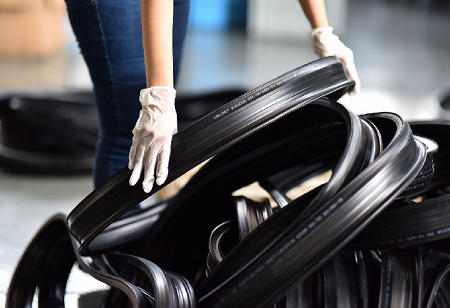Rubber industry has come a long way in the past decade. From producing largely for the domestic market, it has gradually spread its wings and is now exporting to global markets. This is a testimony to the capability of the rubber industry in India. With diverse applications in various industries and for different use cases, rubber products have become the integral cog of the finished goods in a host of industries.
It is the uniqueness of this industry that you can see two different groups of manufacturers coexisting with each other and availing access to their respective market share. On the one hand there are established big players which are mostly into the primary demand segment of tyres, and on the other hand we have small and mid-sized rubber manufacturers that are catering to every demand of rubber from almost all industries.
If we look at the value chain of rubber industry, we can see it starting with natural rubber plantations and ending with a multifarious range of dry rubber and latex based products.
Traditionally, natural rubber has been a regulated commodity with stringent tariff protection and domestic market regulations. However, the recent initiatives from institutional bodies aiming at self-sufficiency and import substitution have worked in favour of the Indian rubber industry.
Move towards multi-functionalized synthetic tyres
Although until now there has been majority of usage of natural rubber, the trend is changing fast. In the industrial products segment, we can see increasing orientation towards production of multi-functionalized synthetic tyres owing to the fact that they exhibit better mechanical properties and enable enhanced fuel efficiency. The obvious benefits of improved physical stability and safety in contrast to traditionally made tyres are expediting the adoption of multi-functionalized tyres in the automotive industry.
Given the fact that it is a labour-intensive industry, rubber product manufacturing has 6,000 MSMEs in total employing more than 6 lakh people directly. Other than the automotive sector, the domestic rubber industry is growing with the effect of demand impetus from mining, medical, aerospace, agriculture, construction, machinery, engineering and electrical appliance manufacturing industries.
The Association of Natural Rubber Producing Countries (ANRPC) had in its October report said that the world consumption outlook for the year 2020 will witness a reduction by 67,000 tonne to 12.611 million tonne, an 8.4 per cent decrease from last year. The report is a marginal revision of the consumption outlook for 2020 arriving at a conclusion of early economic recovery and acceleration in growth. “The outlook of rubber consumption in India and the manufacturing activities will restore momentum with auto sector taking a U-turn in the country,” said the report which has been true so far if we look at the output and revival of automotive sector.
